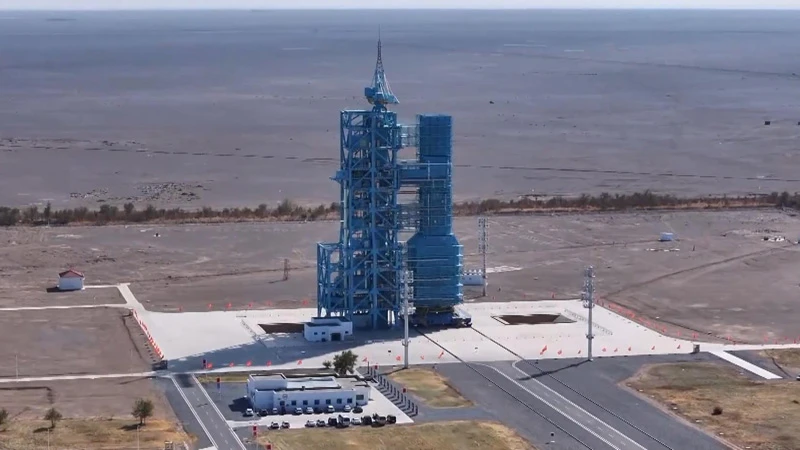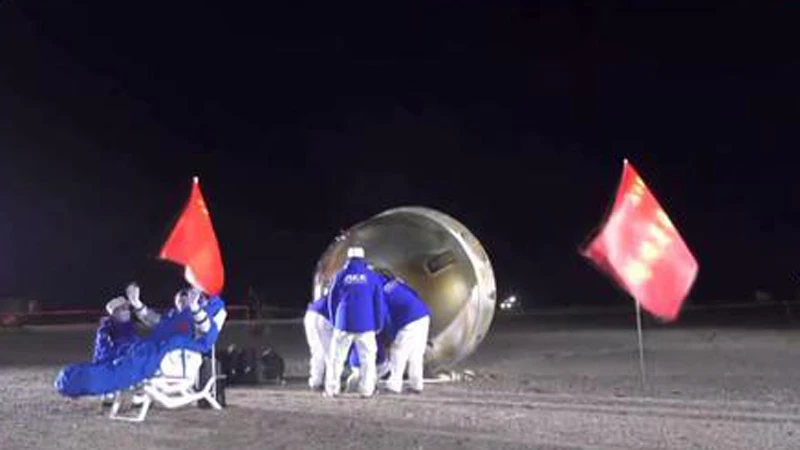On November 4th, 2024, at 1:24 AM Beijing time, the Shenzhou 18 crew, consisting of astronauts Ye Guangfu (叶光富), Li Cong (李聪), and Li Guangsu (李广苏), successfully re-entered Earth's atmosphere after 192 days aboard China's Tiangong (天宫) space station. During their mission, the astronauts completed two spacewalks and set a new record for the longest single spacewalk by a Chinese astronaut. However, beyond the astronauts' remarkable achievements in space, the mission's success depended heavily on the cutting-edge technology developed by the Xi'an Branch of the China Aerospace Corporation (CASC), which ensured the crew's safe return. This technology provided vital communication, navigation, and emergency protocols, making the astronauts' journey back to Earth as secure as possible.
One of the key components was the upgraded relay terminal, which established a crucial communication link between the spacecraft and mission control. This "space highway" ensured that vital data, including health metrics and mission status, were transmitted smoothly during the return journey. The relay system bridges the spacecraft and Earth-based systems, allowing constant monitoring and communication. Without this reliable communication link, the risks associated with the crew's return would have been far more significant. This real-time exchange of information was particularly critical in monitoring the astronauts' health and ensuring they received the proper support as they made their way back to Earth after months in space. The communication system also helped guide the spacecraft through its re-entry phase, making the process more predictable and controlled.

Reinforcing Safety with Advanced Autonomous Systems
Ensuring astronaut safety on such long-duration missions requires more than communication—it involves proactive systems that can take over in emergencies. One such system for the Shenzhou 18 crew was the spacecraft's emergency autonomous return protocol. In the event of a loss of communication between the spacecraft and mission control, this system would calculate the spacecraft's re-entry trajectory, ensuring the astronauts would still return to Earth safely.
The system relied on sophisticated onboard software, which functioned like a "smart assistant" for the astronauts, constantly monitoring the spacecraft's conditions and autonomously adjusting the spacecraft's return trajectory when needed. The software could also predict the landing area in an emergency, ensuring the spacecraft landed in the safest possible location. This redundancy system significantly boosted the overall safety of the mission, providing the ultimate assurance that the astronauts would be able to navigate their way back to Earth, even without ground support. Additionally, this autonomous system gave the crew peace of mind, knowing that the spacecraft could still execute an emergency return without relying solely on mission control's instructions. Implementing such advanced technology exemplifies China's ability to create highly resilient spaceflight systems.
As the spacecraft descended toward Earth, a crucial final step was ensuring the astronauts could be quickly located by search and rescue teams. The spacecraft's antenna network, developed by the Xi'an branch, played a vital role. Upon landing, the network activated, transmitting signals that pinpointed the spacecraft's location to rescue teams on the ground.
The network was not just a communication tool; it was a lifeline. It managed a variety of signal types, from communications and control to rescue and navigation, ensuring that the ground teams could track the spacecraft and perform the necessary recovery operations quickly and efficiently. The antenna system worked in tandem with the spacecraft's other safety features, ensuring that the crew would not be stranded even in challenging circumstances. This aspect of the mission was essential given the vast land the crew could land in, far from the immediate vicinity of recovery teams.
Furthermore, the antenna network also played a key role in assisting with the spacecraft's post-landing procedures. It provided accurate location information that allowed recovery teams to quickly find and reach the capsule, ensuring a fast and efficient crew extraction. The coordination between the spacecraft's communication systems and ground-based teams demonstrated the comprehensive nature of the mission's safety planning, where every possible scenario was anticipated and accounted for.
A Triumph of Engineering and Innovation
In conclusion, the safe return of Shenzhou 18's astronauts was a monumental achievement in China's space program. The advanced systems and technologies developed for the mission were not just about ensuring communication or navigation—they were about creating a network of safety nets that guaranteed the astronauts' return. From the communication relay that bridged the gap between space and Earth to the autonomous systems that could take over in a crisis, every detail of the mission was meticulously planned. This mission highlighted the technical prowess of China's space engineers and underscored the importance of technological innovation in keeping astronauts safe during space exploration.
The triumphant return of Shenzhou 18 is a testament to the dedication and ingenuity of the Chinese space program, illustrating the increasing sophistication of China's space exploration efforts. It highlights the critical role that space technology plays in ensuring the well-being of astronauts and the future of long-term space missions. As China continues to expand its presence in space, the lessons learned from Shenzhou 18 will undoubtedly influence future missions, setting new standards for space safety and communication. This mission has proven that China is capable of sending astronauts into space and bringing them home safely, no matter the challenges faced along the way.


